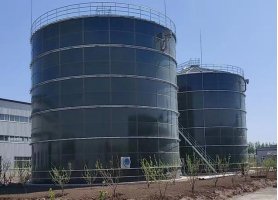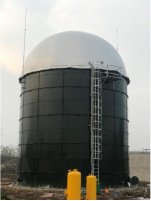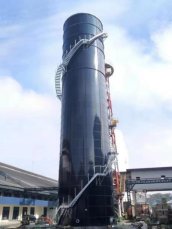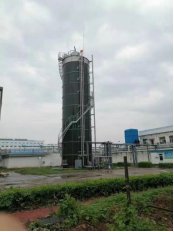1. CSTR
Process advantages:
1. The reactor does not have a three-phase separator and other components.
2. The accumulation of relatively heavy solids maintains a high sludge and microbial content in the reactor.
3. The floating scum layer is not prone to blockage, resulting in high gas production efficiency.
4. Biogas rises with the water flow, providing mixing and stirring effects without the need for a mixer, resulting in low energy consumption.
5. When operating in overload conditions, sludge settling performance may deteriorate, leading to lower organic degradation rates, but usually does not cause acidification.
6. High removal rate of suspended solids (60%-70%).
Process disadvantages:
1. Poor control of suspended solid concentration in the feed, prone to clogging of water distribution pipes, and short-circuiting.
2. For materials with high cellulose content, crust formation at the top is common, posing significant safety risks.
3. The COD content in the slurry is relatively high, making it unsuitable for anaerobic treatment in sewage treatment for standard discharge; typically used for resourceful and ecological treatment in agricultural fertilization.
4. Generally only suitable for anaerobic digestion of livestock and poultry manure.
5. The structure is relatively strict, and the individual volume is generally small.


1. UASB
Advantages:
1. High organic load and excellent treatment efficiency, significantly reducing the reactor volume due to the short hydraulic retention time.
2. Enhanced resistance to adverse conditions through sludge granulation.
3. No need for stirring and sludge reflux equipment, saving energy consumption.
4. The three-phase separator eliminates the need for sedimentation and degassing devices, reducing operating costs.
5. No need to add fillers or carriers inside the reactor, increasing volumetric utilization.
6. Low suspended solids (SS) concentration in the effluent, commonly used for the anaerobic stage in wastewater treatment processes aiming at standard discharge.
Disadvantages:
1. The domestication time for granular sludge is relatively long, leading to a prolonged startup period.
2. Short-circuiting phenomena occur in the sludge bed, with a maximum reaching 70-80%, affecting the treatment capacity.
3. Sensitivity to water quality and load, limited buffering capacity, and a high requirement for the stability of influent water quality.
4. Minimal impact on removing nitrogen and phosphorus from wastewater, requiring additional complementary removal processes in subsequent stages.
5. Not suitable for wastewater with a high concentration of suspended solids (SS).
6. Applications:
7. Aquaculture and slaughterhouse wastewater.
8. Chemical and pharmaceutical wastewater.
9. Papermaking and food processing wastewater, among others.


1. IC
Advantages:
1. Dual-layer reaction bed with a high volumetric load, elevated sludge concentration, abundant microbial population, and internal circulation, ensuring excellent mass transfer efficiency with an influent load up to three times that of conventional reactors.
2. The reactor has a high aspect ratio (typically 4-8), minimizing the footprint.
3. Strong shock load resistance—ample circulation water and influent thoroughly mix, diluting harmful substances in raw water and reducing their impact on anaerobic reactions.
4. Internal automatic circulation eliminates the need for external pump circulation, reducing energy consumption.
5. Short startup period with high sludge activity and rapid biological proliferation within the reactor.
Disadvantages:
The internal structure of the reactor is complex, requiring high design and construction standards, resulting in a significant initial investment.
The reactor has a high aspect ratio, increasing the power consumption of influent pumps and operational costs.
The lift pipes and mixing pipes in the internal circulation can easily become clogged, leading to circulation paralysis and poor treatment efficiency.
The relatively short hydraulic retention time results in poor treatment efficiency for organic substances that are not easily soluble in water.
The commissioning phase requires a large amount of active sludge, increasing costs.
Applications:
Mainly used for the treatment of high-concentration organic wastewater, sewage with high suspended solids content, and wastewater containing microbial toxicity.
Examples include wastewater from corn starch, citric acid, beer, potato processing, and alcohol production.

